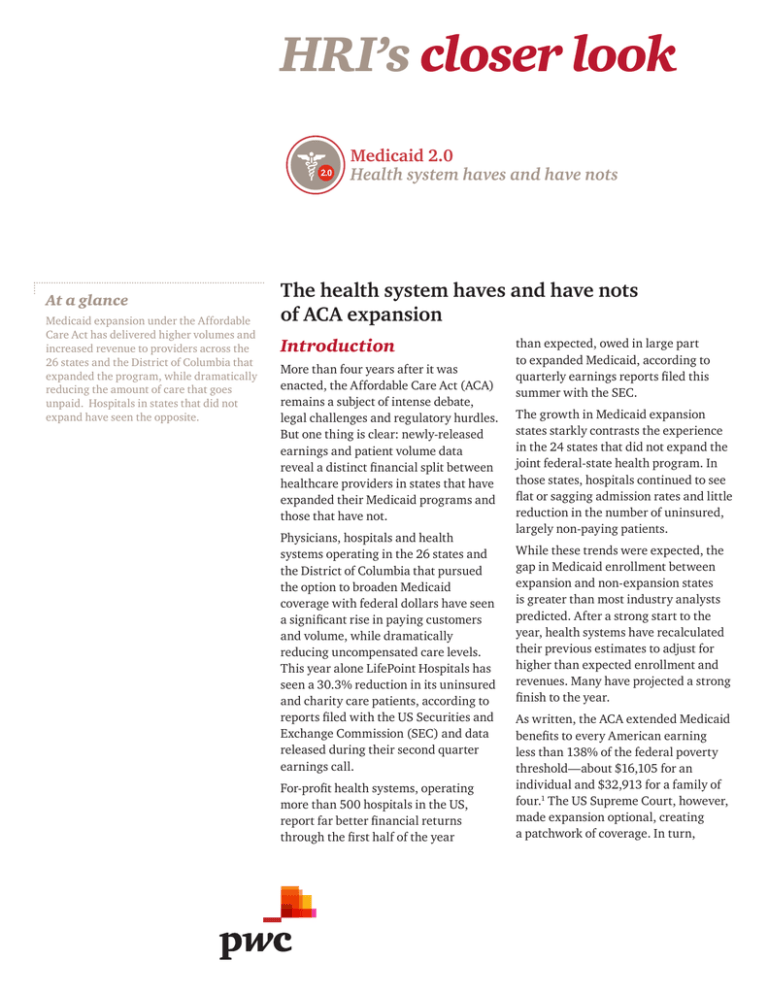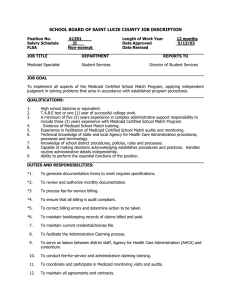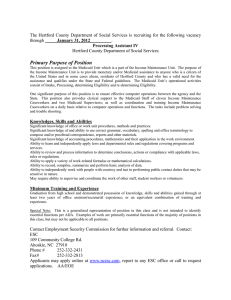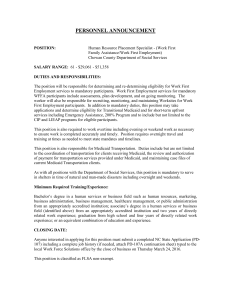
HRI’s closer look
2.0
At a glance
Medicaid expansion under the Affordable
Care Act has delivered higher volumes and
increased revenue to providers across the
26 states and the District of Columbia that
expanded the program, while dramatically
reducing the amount of care that goes
unpaid. Hospitals in states that did not
expand have seen the opposite.
Medicaid 2.0
Health system haves and have nots
The health system haves and have nots
of ACA expansion
Introduction
More than four years after it was
enacted, the Affordable Care Act (ACA)
remains a subject of intense debate,
legal challenges and regulatory hurdles.
But one thing is clear: newly-released
earnings and patient volume data
reveal a distinct financial split between
healthcare providers in states that have
expanded their Medicaid programs and
those that have not.
Physicians, hospitals and health
systems operating in the 26 states and
the District of Columbia that pursued
the option to broaden Medicaid
coverage with federal dollars have seen
a significant rise in paying customers
and volume, while dramatically
reducing uncompensated care levels.
This year alone LifePoint Hospitals has
seen a 30.3% reduction in its uninsured
and charity care patients, according to
reports filed with the US Securities and
Exchange Commission (SEC) and data
released during their second quarter
earnings call.
For-profit health systems, operating
more than 500 hospitals in the US,
report far better financial returns
through the first half of the year
than expected, owed in large part
to expanded Medicaid, according to
quarterly earnings reports filed this
summer with the SEC.
The growth in Medicaid expansion
states starkly contrasts the experience
in the 24 states that did not expand the
joint federal-state health program. In
those states, hospitals continued to see
flat or sagging admission rates and little
reduction in the number of uninsured,
largely non-paying patients.
While these trends were expected, the
gap in Medicaid enrollment between
expansion and non-expansion states
is greater than most industry analysts
predicted. After a strong start to the
year, health systems have recalculated
their previous estimates to adjust for
higher than expected enrollment and
revenues. Many have projected a strong
finish to the year.
As written, the ACA extended Medicaid
benefits to every American earning
less than 138% of the federal poverty
threshold—about $16,105 for an
individual and $32,913 for a family of
four.1 The US Supreme Court, however,
made expansion optional, creating
a patchwork of coverage. In turn,
health systems in states that chose not
to expand are under added financial
pressure. Between 2014 and 2020,
federal support to hospitals serving the
uninsured will decline by more than
$39 billion.
The impact is only now becoming clear.
If left unchanged, about 6.7 million
people would remain uninsured in
2016 across the 24 non-expansion
states, according to estimates by the
Robert Wood Johnson Foundation and
Urban Institute.2 Those same states
would give up about $423 billion in
federal Medicaid dollars through 2022.
What’s more, health systems located in
non-expansion states could lose about
$167 billion in enhanced Medicaid
payments used to offset reductions in
federal reimbursement.3
Since the ruling in 2012, state and
national hospital groups have urged
lawmakers in non-expansion states
to reconsider. Most recently, federal
health officials approved Pennsylvania’s
proposal to expand Medicaid beginning
in 2015. One overarching reason is
the imbalance in Medicaid payment
between expansion and non-expansion
states. The federal government covers
the cost of expansion for all new
enrollees through 2017. While the
government’s share eventually tapers
off to 90%, the infusion of Medicaid
dollars has been a boon for healthcare
providers, patients and state budgets.
Even so, many governors in
non-expansion states see a different
calculus, often citing Medicaid’s strain
on state budgets and concerns over
how the program is managed at the
federal level. Texas Gov. Rick Perry,
for instance, said Medicaid expansion
would cost $15.6 billion over the next
decade.4 Other governors say they are
uneasy about relying on the federal
government for payments to offset the
cost of the expansion population.
To assess the impact of Medicaid
expansion, PwC’s Health Research
Institute (HRI) analyzed financial data
from the nation’s five largest for-profit
health systems—HCA Holdings,
LifePoint Hospitals, Tenet Healthcare,
Community Health Systems and
Universal Health Services, representing
538 hospitals in 35 states. Combined
with information from several
mid-sized hospitals, government
reports, industry surveys and executive
interviews, the data present a fuller
picture of how the largest expansion of
coverage in a generation is impacting
the nation’s $2.8 trillion health sector.
Figure 1. Admissions for self-pay patients were down for these hospitals through the first half of 2014
Community Health Systems
HCA
LifePoint Hospitals
Tenet Healthcare
Universal Health Services
1.0%
0.3%
-1.0%
-3.8%
-6.3%
-6.5%
-6.6%
-9.3%
-14.7%
Total admissions
Self-pay admissions
-30.3%
Note: Same facility admissions (first half 2014 vs first half 2013)
Source: PwC Health Research Institute analysis
PwC Health Research Institute: Medicaid 2.0
The health system haves and have nots of ACA expansion
2
Hospitals split between
haves, have nots
Insurance coverage for virtually all
Americans is at the core of an agreement
hospital executives made with the
Obama administration when the ACA
was being written. Create a clear path
for Americans to gain coverage—either
through the expansion of Medicaid or
new public exchanges—and hospitals
would agree to more than $150 billion
in reduced Medicare payments to help
pay for the law.
There’s evidence the tradeoff is
working. Medicaid admissions in
expansion states increased by a range of
10.4% to 32% across the country’s three
largest health systems since the start of
the year. Those double-digit percentage
increases were met with corresponding
declines of about 47% over the first
half of the year in uninsured or self-pay
admissions, which typically include a
large portion of uncompensated care.
Approximately 7.2 million Americans
enrolled in Medicaid and its children’s
health component since October 2013,
according to the Centers for Medicare
and Medicaid Services (CMS). Those
sign-ups mark a 12.4% overall increase
over average monthly enrollment prior
to the ACA changes.5 Expansion states
saw enrollment increase 18.5%. States
that declined to expand Medicaid also
saw a 4% increase in enrollment, in
part due to a greater awareness around
Figure 2. In Medicaid expansion states, the shifts between Medicaid and self-pay
admissions were dramatic through the first half of 2014
Community Health Systems
HCA
Tenet Healthcare
32.0%
20.5%
10.4%
-47.6%
Medicaid admissions
Note: Same facility admissions (first half 2014 vs first half 2013)
Source: PwC Health Research Institute analysis
PwC Health Research Institute: Medicaid 2.0
-48.0%
-46.0%
Self-pay admissions
new coverage options and a simplified
path to enrollment.6
Education efforts around the ACA’s
coverage expansion played a key role
in driving-up coverage rates. Dallasbased Tenet Healthcare, for instance,
held more than 350 events to raise
awareness of exchange health plans
and new Medicaid thresholds. Tenet
President and Chief Executive Trevor
Fetter said the effort lead to “tens of
thousands” of newly-enrolled Medicaid
recipients.7
Tenet operates hospitals in five states
that expanded Medicaid. Across
those states, Tenet saw uninsured and
charity care admissions decline by
46%, coupled with a 20.5% increase
in Medicaid admissions in those same
states, according to an HRI analysis. In
the second quarter alone, Tenet saw a
$78 million reduction in unpaid care.8
Newly covered Medicaid enrollees
helped buoy hospital earnings
elsewhere, too. Franklin, Tenn.-based
Community Health Systems operates
hospitals in 29 states, including 12 that
expanded the program. Those states
account for just under a quarter, 23%, of
Community Health’s overall revenue yet
provided a major financial lift, in part
because self-pay emergency room visits
declined 41%. Community Health has
seen a corresponding 10.4% increase in
Medicaid admissions through the first
half of this year compared to the same
period in 2013.9
The surge in new paying customers
under the ACA’s coverage expansion,
and subsequent reduction in uninsured
patients, accounts for about $40 million
to $45 million of Community Health’s
earnings, company executives said,
adding that they expect another $40
million benefit through the second half
of the year.10
The health system haves and have nots of ACA expansion
3
The country’s largest hospital chain,
HCA Holdings, revised its earnings
outlook to account for better-thanexpected revenue from health reform.
The company operates in five Medicaid
expansion states. Within their
expansion states, Medicaid admissions
increased 32%, with a corresponding
48% decline in uninsured admissions
through the first half of the year,
according to an HRI analysis.
Uninsured volume also declined in
non-expansion states, though much less
rapidly at 2%.11
And LifePoint Hospitals operates in
20 states—seven of which expanded
Medicaid. The health system saw
second-quarter earnings of about
$158.7 million, a 35.8% increase
over the same span in 2013. Of that,
LifePoint executives attribute about
$13 million to the ACA’s coverage
expansion. About 80% of LifePoint’s
newly-covered admissions came from
Medicaid in the second quarter.12
Similarly, Pennsylvania-based
Universal Health Services reported
a 30% increase in second-quarter
adjusted net income, to $155.6 million
compared to $118.9 million during the
same period a year ago.13
“We knew there would be movement
from uninsured to insured,” said Chris
Tholen, vice president of financial
policy at the Colorado Hospital
Association. Researchers at the
association analyzed Medicaid coverage
data over the first three months of 2014
for more than 400 hospitals across
30 states—half of which expanded
the program. The study revealed a
29% increase in Medicaid volume in
expansion states. “Everybody expected
the increases, but I would say that these
are bigger overall than what we would
have thought.”14
PwC Health Research Institute: Medicaid 2.0
Doctors experience an
expansion “bump”
The expansion had a similar impact
on doctors. Primary care physicians,
surgeons and other specialists
in expansion states saw a higher
percentage of Medicaid patients during
the first three months of 2014 than were
seen in non-expansion states.15
Tholen said another lasting effect of
states that do not expand Medicaid
could be a legacy of unhealthier
patients. “Take away the finance for
a second and think about the mission
of hospitals, which is to improve the
health of a population,” he said. “An
insured community is a healthier
community. I don’t want to lose sight of
that either.”
In Arkansas, which is using a federal
waiver to apply Medicaid dollars to
subsidize individuals purchasing
on the state exchange, the coverage
expansion also has boosted physician
office volume, said Jodiane Tritt, vice
president for government relations at
the Arkansas Hospital Association.
“We expected our emergency rooms to
uptick,” she said. “They didn’t.”
In a statewide survey of 42 hospitals,
the association found a 2% decline
in emergency department visits.
Patients that were admitted, however,
increasingly had coverage. Arkansas
hospitals saw about a 30% decline in
uninsured patients.
“These folks have private insurance,
and they’re going to primary care
physicians around the state,” said
Tritt, adding that the higher-paying
option means fewer doctors turning
away from Medicaid because of its low
reimbursement rates.
“That means our emergency rooms are
not getting overcrowded, doctors are
finally getting paid—particularly in
rural Arkansas for seeing patients who
now have a payment source they never
had before—and the folks that really do
need inpatient care are coming to us at
the appropriate time, and they have a
paying source,” she added.
At the same time, Arkansas is
considering proposals to require low
income beneficiaries to contribute $5
to $25 each month to a health savings
account, which will then be used to pay
deductibles, copays and co-insurance.
Those who don’t make the payments
will be subject to copayments when
they receive care.
Conclusion
In states that have expanded Medicaid,
an influx of newly insured patients has
helped reverse long-running hospital
trends such as declining admissions
and a rise in uncompensated care.
Given the emerging picture of health
system haves and have nots, it is
understandable why many hospital
executives continue to urge state
lawmakers to expand Medicaid where
they haven’t already.
Hospitals in expansion states have
already seen a pick-up in volume.
As more and more people seek out
routine primary care, a community’s
overall health should improve. But in
non-expansion states, lower- income
individuals may continue to have
limited access to care and strain the
safety net.
“I think it speaks for itself—it’s
logical,” said Chip Kahn, president of
the Federation of American Hospitals.
“It says that the expansion has had a
material effect on those areas.”
The health system haves and have nots of ACA expansion
4
Endnotes
1. Medicaid expansion and what it means for you, US Department of Health & Human Services, www.healthcare.gov
2. “What is the Result of States Not Expanding Medicaid?” Robert Wood Johnson Foundation and Urban Institute,
Stan Dorn, Megan McGrath, John Holahan, August 2014
3. “What is the Result of States Not Expanding Medicaid?” Robert Wood Johnson Foundation and Urban Institute,
Stan Dorn, Megan McGrath, John Holahan, August 2014
4. Dallas Morning News, Parkland Seeks 10% Property Tax Increase to Cover New Building, Sherry Jacobson, August
12, 2014.
5. Medicaid & CHIP: June 2014 Monthly Applications, Eligibility Determinations, and Enrollment Report, August 8,
2014, Centers for Medicare & Medicaid Services
6. Medicaid & CHIP: June 2014 Monthly Applications, Eligibility Determinations, and Enrollment Report, August 8,
2014, Centers for Medicare & Medicaid Services
7. Tenet Healthcare Second Quarter 2014 Earnings, transcribed from a conference call, August 5, 2014
8. Tenet Healthcare Second Quarter 2014 Earnings, transcribed from a conference call, August 5, 2014
9. Community Health Systems Second Quarter 2014 earnings, transcribed from a conference call, and HRI analysis.
10. Community Health Systems Second Quarter 2014 earnings, transcribed from a conference call, August 1, 2014
11. HCA Holdings Inc., Second Quarter 2014 earnings, transcribed from a conference call, July 29, 2014
12. LifePoint Hospitals, Second Quarter 2014 earnings, transcribed from a conference call, July 25, 2014
13. Universal Health Services Second Quarter 2014 earnings, transcribed from a conference call, July 25, 2014
14. Impact of Medicaid Expansion on Hospital Volumes, June 2014, Colorado Hospital Association
15. ACA View, Tracking the Impact of Health Care Reform, July 14, 2014, Robert Wood Johnson Foundation and
AthenaHealth,
PwC Health Research Institute: Medicaid 2.0
The health system haves and have nots of ACA expansion
5
Acknowledgements
Paul Cunningham
Executive Vice President
Arkansas Hospital Association
Charles “Chip” Kahn III
President and Chief Executive
Federation of American Hospitals
Chris Tholen
Vice President, Financial Policy
Colorado Hospital Association
Jodiane Tritt
Vice President for Government Relations
Arkansas Hospital Association
HRI Regulatory Team
Ceci Connolly
HRI Managing Director
(202) 312-7910
ceci.connolly@us.pwc.com
Benjamin Isgur
Director
(214) 754-5091
benjamin.isgur@us.pwc.com
Bobby Clark
Senior Manager
(202) 312-7947
robert.j.clark@us.pwc.com
Matthew DoBias
Senior Manager
(202) 312-7692
matthew.r.dobias@us.pwc.com
HRI Advisory team
Caitlin Sweany
Senior Manager
(202) 346-5241
caitlin.sweany@us.pwc.com
Sandra Hunt, Principal
Melanie Dunn
Research Analyst
(646) 471-4974
melanie.a.dunn@us.pwc.com
Angelina Payne, Manager
Joe Albian, Principal
Ari Gottlieb, Director
Gary Jacobs, Managing Director
Susan Maerki, Director
Robert Valletta, Partner
Contacts
Kelly Barnes
US Health Industries Leader
(214) 754-5172
kelly.a.barnes@us.pwc.com
Robert Valletta
US Health Services Leader
(617) 530-4053
robert.m.valletta@us.pwc.com
Ceci Connolly
HRI Managing Director
(202) 312-7910
ceci.connolly@us.pwc.com
Health Research Institute
About PwC
PwC’s Health Research Institute provides
new intelligence, perspectives and analysis
on trends affecting all health-related
industries. The Health Research Institute
helps executive decision makers navigate
change through primary research and
collaborative exchange. Our views are shaped
by a network of professionals with executive
and day-to-day experience in the health
industry. HRI research is independent and not
sponsored by businesses, government or other
institutions. The HRI regulatory team tracks
legislative and regulatory issues across the
health industries and delivers the most timely,
relevant and thought-provoking business
insights in a concise, easily-accessible format.
PwC US helps organizations and individuals
create the value they’re looking for. We’re a
member of the PwC network of firms with
180,000 people in more than 155 countries.
We’re committed to delivering quality in
assurance, tax and advisory services. Tell
us what matters to you and find out more by
visiting us at www.pwc.com/us.
www.pwc.com/us/hix
www.pwc.com/us/healthindustries
www.pwc.com/hri
twitter.com/PwCHealth
© 2014 PwC. All rights reserved. “PwC” and “PwC US” refer to PricewaterhouseCoopers LLP, a Delaware limited liability partnership, which is a member firm of
PricewaterhouseCoopers International Limited, each member firm of which is a separate legal entity. This document is for general information purposes only, and should not be
used as a substitute for consultation with professional advisors. MW-15-0155








